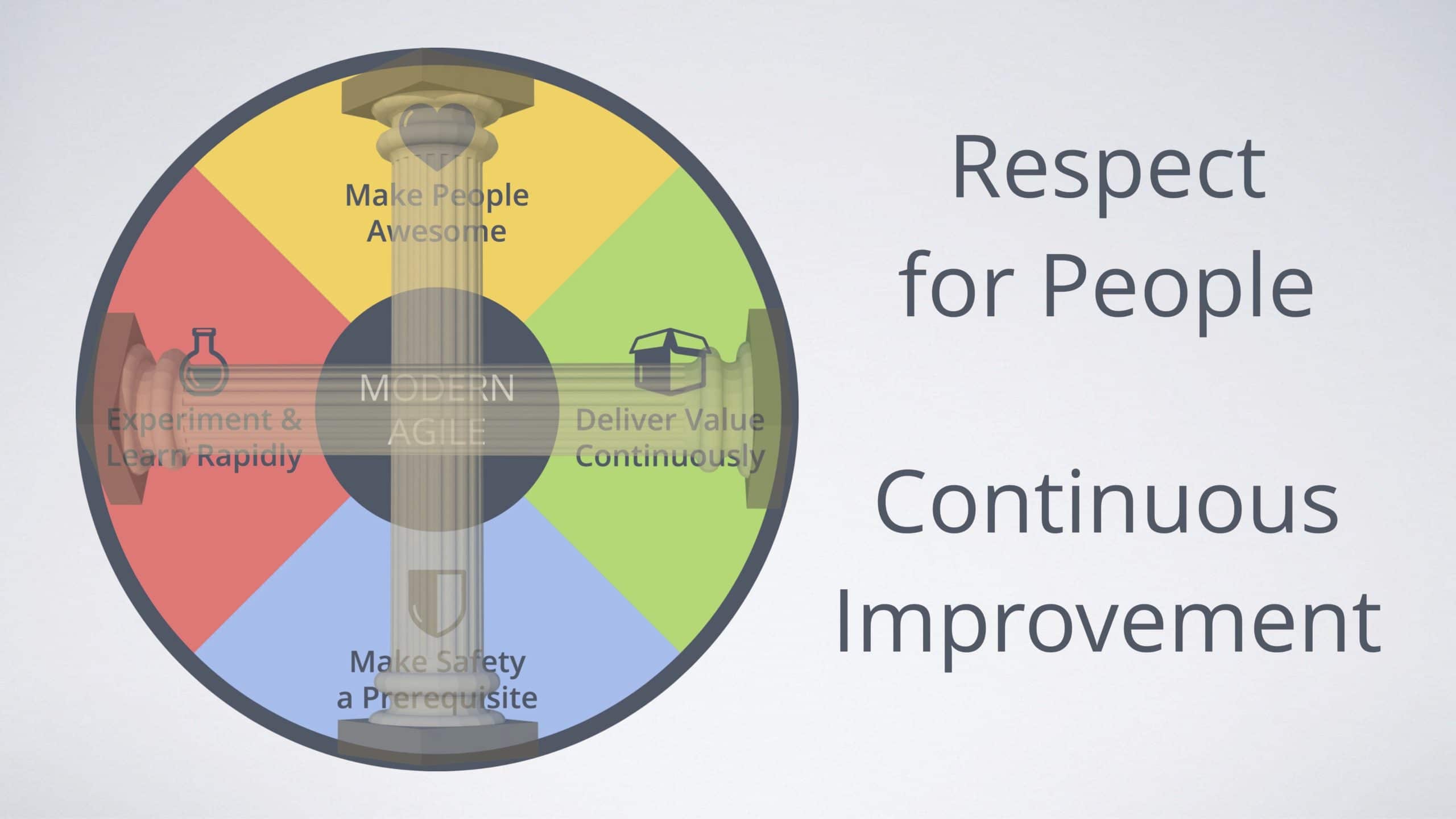
Nous sommes déjà en 2019 cette année, et cela fait maintenant près de 18 ans que le Manifeste Agile a vu le jour ! Beaucoup de personnes se sont posés la question ces dernières années à savoir si ce document avait toujours lieu d’être ou s’il méritait d’être mis à jour : comme toute notion mérite de s’adapter à un contexte en changement permanent ! En effet, nous voyons aujourd’hui que l’Agilité ne s’arrête plus au domaine du développement logiciel (en supposant qu’il l’ait été un jour :-P) et donc que la terminologie utilisée n’est pas suffisamment parlante pour tout le monde.
J’avais entendu parlé de Modern Agile au sein de la communauté mais n’avait pas encore pris le temps de m’y intéresser. Voici chose faite !
C’est un mouvement impulsé par Joshua Kerievsky, CEO d’Industrial Logic, qui a vocation à redonner un second souffle à l’Agilité que l’on connaît traditionnellement en lui conférant tous les apprentissages acquis depuis toutes ces années.
Je vous propose de découvrir ensemble dans cet article ce qu’est Modern Agile afin de voir tout ce que cette perspective peut nous apporter ! 🙂
Origines

Pour démarrer notre découverte, autant retourner aux sources. Je me suis alors intéressé à la Keynote donnée par Joshua Kerievsky à l’Agile Conference 2016 où il présenta les concepts de Modern Agile.
| Note : Je vous invite vraiment à la voir, Joshua est un speaker de qualité et sa conférence l’est tout autant ! |
Une histoire

Joshua nous raconte qu’il est un jour intervenu dans une entreprise dans laquelle il a eu une réunion de travail avec une manager. Dans la salle était affiché au mur plein de posters avec les notions traditionnelles du type Burndown chart ou Cartographie de Release.
Un échange débuta alors entre eux :
Joshua : Comment cela se passe pour vous ?
Manager : Très bien !
Joshua, sentant autre chose et regardant tous les posters au mur : Et comment tout cela marche pour vous ?
Manager, après quelques minutes : Vous voulez la vérité ?
Joshua : Oui bien sûr je veux la vérité !
Manager : En réalité, on ne fait rien de tout cela, ces posters ont été fait parce que l’on savait que vous veniez !
Joshua : Que faites-vous vraiment alors ?
Manager : Disons que l’on se réunit, on choisit le travail à faire, on estime à la louche ce que l’on pense pouvoir faire et puis on le fait ! Des fois ça marche des fois ça ne marche pas mais ce n’est pas grave. Voilà c’est à peu près ce que l’on fait !
Joshua : C’est à peu près ce que l’on fait aussi !
| Note : La gêne que l’on peut sentir dans le discours de la Manager est similaire à ce que nous exprimions avec Fabien Maury dans notre conférence liant Agilité et Anarchisme, lorsqu’en entretien, des clients devaient parler de leur Agilité actuelle : « On est (presque) en Scrum », « Oui on fait de l’Agilité, enfin on essaie », « Oui on fait de l’Agile hybride ».
Il m’apparaît intéressant de réfléchir à ce qui emmène les personnes à penser que ce qu’elles font est bien ou non : serait-ce parce qu’elles mettent bien en oeuvre les pratiques Agile ou parce qu’elles répondent aux principes Agile à leur manière ? |
Cette histoire est très représentative de la vision que les entreprises peuvent avoir de l’Agilité aujourd’hui : une simple boite à outil avec des pratiques à mettre en oeuvre. Désolé mais seulement instaurer les rituels ne rend pas Agile !
Joshua raconte que dans son expérience il lui arrivait de voir des processus dits « Agile » encore plus lourds que les précédents ! Il comparait la sensation qu’il avait à lorsque l’on voit des personnes avec des ordinateurs portables extrêmement lourds alors qu’il existe aujourd’hui des machines extrêmement fines et légères ! Cela vous parle n’est-ce pas ? 😛
De plus, ces entreprises tendent à se raccrocher à de la terminologie et à des pratiques comme les « sprints« , les « burndown charts« , les « story points« , la « vélocité » sans pour autant en comprendre les intentions.
Il est intéressant de voir que les signataires du Manifeste Agile eux-même peuvent remettre en cause certaines de ces pratiques :
J’ai peut-être inventé les points. Si c’est le cas, j’en suis désolé à présent.
– Ron Jeffries, dans cet article
La vélocité est en train de tuer l’Agilité !
– Jim Highsmith, dans cet article

Il n’y a donc en soi rien de mal à partir de là, c’est juste que, comme la dette technique, il faut penser à réévaluer l’impact que cela peut avoir sur notre fonctionnement au global par la suite.

C’est une notion qui m’apparaît très intéressante dans le sens où lorsque j’évoque les valeurs du Manifeste Agile, je parle souvent de curseur à trouver entre les éléments de gauche et les éléments de droite – curseur qui peut bien sûr dynamiquement évoluer selon les besoins du moment.
Ainsi, comme le dit Joshua, l’Agilité traditionnelle peut manquer de direction et c’est probablement une des raisons pour lesquelles beaucoup de transformation Agile se font dans la douleur au sein des équipes.
La naissance de Modern Agile
Cela fait maintenant près de 18 ans que le Manifeste Agile a vu le jour et comme toute chose, la question de la mise à jour s’est posée. C’est lors d’un Open Space que Joshua a proposé ce thème, afin de voir quels étaient les éléments vraiment pertinents à garder à ce jour, ce qui généra beaucoup d’émule.

En effet, de nombreux sujets ont alimenté la manière dont on fait de l’Agilité aujourd’hui : que ce soit autour du Management 3.0 de Jurgen Appelo, du Kanban de David J. Anderson, en passant par le Lean Startup d’Eric Ries ou encore le Pouvoir des Habitudes de Charles Duhigg. Tous ces sujets font partie intégrante des préoccupations des praticiens de l’Agilité et cela est difficilement abordable sous la forme actuelle du Manifeste Agile, très orienté développement logiciel.
Ainsi, il n’y a pas forcément de « nouveauté » dans Modern Agile, ce qui peut poser la question du terme « Modern ». En réalité, Joshua nous partage le fait que ce terme est utilisé pour dire que malgré le fait que l’on est nombreux à savoir aujourd’hui ce qui fonctionne et est utile, ce n’est pas connu de tout le monde et cela mérite d’être partagé. En effet, la sagesse peut être toujours applicable aujourd’hui, les pratiques pas forcément !
Le futur est déjà là, il n’est juste pas uniformément distribué
– William Gibson, Author
Modern Agile se veut donc léger et comporte seulement 4 grands principes directeurs :

Avant de rentrer plus en détails dans ces principes, il m’est apparu intéressant de citer une inspiration supplémentaire : le Toyota Production System.
Comme le précise Joshua, on peut retrouver 2 piliers de TPS sur la figure :
- le Respect des Individus : en reliant les principes de Rendre les personnes fantastiques et Faire de la sécurité un prérequis.
- l’Amélioration Continue : en reliant les principes d’Expérimenter et Apprendre rapidement et Apporter de la valeur en continu.

Bon allez, rentrons un peu plus dans les détails de ces principes ! 😉
Rendre les gens fantastiques

Lorsque l’on lit ce principe, cela peut apparaître un peu utopique… et pourtant ! La terminologie originale est « Make people awesome » ce qui est très anglo-saxon mais qui est très révélateur de ce que l’on cherche à faire : rendre les personnes géniales pour transformer le monde, pour acheter en un seul clic, pour faire des produits de grandes qualités, pour coopérer vers un objectif commun…
La grande question est donc :
Comment rendre les personnes de notre éco-système fantastiques ?
On parle alors bien de l’ensemble de notre éco-système, ce qui inclue les personnes qui achètent, font, utilisent, vendent ou même qui financent nos produits ou services !
Pour ce faire, il est important d’apprendre à connaître :
- leur contexte,
- leurs sources de souffrance,
- ce qui les empêche aujourd’hui de dévoiler tout leur potentiel,
- ce à quoi ils aspirent…
Malgré un titre d’apparence un peu pompeux, ce principe est extrêmement puissant lorsque l’on voit les questions auxquelles on peut répondre, par exemple :
| Rendre fantastiques | Exemple de Question |
| Les gens qui achètent | Est-ce suffisamment simple pour que je me sente capable d’acheter sans problèmes ? |
| Les gens qui font | Est-ce que notre manière de travailler nous permet de produire un service de qualité ? |
| Les gens qui vendent | est-ce que ma connaissance des utilisateurs me permet de proposer les bonnes offres au bon moment ? |
| Les gens qui utilisent | est-ce que ce produit me donne la capacité de refaire le monde ? |
| Les gens qui financent | est-ce que ce produit me fait suffisamment rêver pour être fier d’investir dedans ? |
Apporter de la valeur en continu

Lorsque l’on parle d’apporter de la valeur en continu, on pense naturellement à la notion de flux, au coeur de la culture du Toyota Production System.
Au sens Lean, la valeur est définie par le client. Il est donc nécessaire de lui livrer au plus vite sa demande afin qu’il puisse en faire usage et devenir fantastique ! 😛
Plus sérieusement, cette notion de livraison rapide au client inclue différents choses :
- Prioriser le travail à prendre en charge : pour maximiser la valeur apporter au client
- Limiter le travail en cours : travailler sur moins de choses en même temps pour garantir notre focalisation à faire sortir les éléments de travail du système
- Réduire la taille des batchs : découper au maximum afin de permettre un débit plus important de production de valeur
- Automatiser les tâches de non production de valeur : utiliser notre intelligence pour les tâches qui le nécessitent vraiment et automatiser le reste pour garantir un flux continu
On retrouve ici toutes les notions amenées par le Kanban et le DevOps au travers de l’automatisation des tests, de l’intégration continue et du déploiement continu. L’important est de réduire au maximum les temps d’attente afin de permettre aux éléments de travail d’atteindre la sortie du système et donc son utilisateur final rapidement.
Faire de la sécurité un prérequis

Lorsque l’on parle de sécurité, c’est principalement de sécurité psychologique dont il est question. En effet, dans une étude effectuée par Google, cet élément s’est avéré clé pour les équipes à haute performance et n’en reste pas moins un besoin fondamental humain.
Mettre en oeuvre ce principe, c’est s’assurer avant toute autre chose que la sécurité psychologique est présente avant de s’engager sur un quelconque élément de travail. La protection du temps, des informations, de la réputation, de l’argent, de la santé et des relations des personnes est alors fondamentale. C’est ainsi rendre ses collaborations, ses produits et services résilients et sûrs.
Si vous avez une culture de la peur, aucune de vos pratiques ou processus fantaisistes ne vous aideront.
– Joshua Kerievsky
Pour commencer, Joshua nous partage quelques astuces pour des réunions plus sûres (adapté de Smarter, faster, better de Charles Duhigg)
- Encourager chacun à contribuer
- S’écouter les uns les autres
- Revoir/Répéter les points des autres personnes
- Éviter la domination et l’interruption
- Être soucieux des autres, curieux et sans jugement : même lorsque quelqu’un dit quelque chose qui vous embête 🙂
On peut ainsi voir dans ce principe toutes les thématiques autour des soft skills nécessaires au travail d’équipe à haute performance : des outils comme la Communication Non Violente et l’Ennéagramme (désolé je n’ai pas pu m’en empêcher :-P) peuvent être de grands alliés pour apprendre à mieux se connaître, mieux comprendre les autres et donc interagir de manière plus sereine.
Expérimenter et apprendre rapidement

Difficile de parler Agilité sans parler d’expérimentation et d’apprentissage. Comme j’ai l’habitude de le dire à présent, le plus difficile n’est pas dans les pratiques mais dans le changement de paradigme. En effet, accepter le fait que l’on ne sait pas et que l’on a besoin de faire pour savoir est loin d’être simple lorsque l’on a été formaté à trouver des solutions par l’analyse.
J’ai eu l’occasion de l’expérimenter lors d’un atelier co-animé avec Caroline Aupert à l’Agile Tour Aix Marseille 2018 intitulé Stratégie et Dynamique d’équipe. En effet, les automatismes reprennent facilement le dessus et l’apprentissage (basé sur les expérimentations donc) n’est pas quelque chose de naturel dans notre culture.
Si l’on en revient à Modern Agile, il est intéressant de voir comment chaque principe se nourrit des autres et vices versa :
- Expérimenter et Apprendre est un moyen de rendre les gens fantastiques, d’apporter de la valeur en continu et de construire un cadre sûr pour les personnes.
- Il est tout aussi important :
- d’avoir des gens fantastiques pour mettre en oeuvre les expérimentations et en ressortir les apprentissages adaptés
- d’avoir une capacité d’amener l’expérimentation à bout afin de pouvoir en retirer les apprentissages espérés
- de construire des expérimentations « Safe to Fail » afin de pouvoir encourager l’initiative et alimenter ce cercle vertueux
On peut ici penser aux outils de structuration d’expérimentation comme le A3 du Lean, la Test Card de Strategizer ou encore PopcornFlow pour suivre ce flux d’apprentissage.
Modern Agile à l’oeuvre

Joshua raconte l’histoire de Taka, un sous-chef d’un restaurant 3 étoiles Michelin du Nord de l’Italie. Alors qu’il devait encore servir 2 tartes au citron à ses convives, Taka fit malheureusement tomber l’une de ses tartes. Elle tomba sur le coté de l’assiette sur le comptoir, et se brisa. Taka fut bien évidemment bien embêté.
Son chef Osteria Francescana Massimo Bottura lui dit :
« Taka, attends, attends. (Faisant un cadre avec ses doigts) Regarde au travers de mes doigts, c’est magnifique. Refaisons le comme si c’était un élément cassé. »
En reproduisant le même design sur l’autre tarte avec grande précision, l’idée était de faire penser aux convives que cela était fait exprès. Ce fut le moment où fut créé « Oops. J’ai fait tombé ma tarte au citron. »
Dans cette histoire, on peut voir les 4 principes de Modern Agile à l’oeuvre :
| Principe Modern Agile | En pratique |
| Rendre les gens fantastiques | Le chef Bottura a su rendre son sous-chef fier d’avoir participé à la création de quelque chose de nouveau, il a su ravir les convives avec un plat d’apparence originale. |
| Apporter de la valeur en continu | Le chef Bottura a su apprécier la situation avec curiosité et focaliser son attention sur ce qui pourrait apporter de la valeur au client tout en ne gaspillant pas le travail et l’effort fourni. |
| Faire de la sécurité un prérequis | Taka ne s’est pas senti mis en danger ou blâmer de quelque sorte, il a réussi à faire confiance pour pouvoir mettre en oeuvre la seconde assiette. |
| Expérimenter et apprendre rapidement | Avoir le courage de mettre en place la seconde assiette et assumer de l’emmener aux convives est bien une expérimentation leur permettant de voir si cela pouvait plaire ! Cet apprentissage leur a permis de transformer ce qui aurait pu apparaître comme une bourde en une anecdote plaisante à raconter ! |
| Note : Voici la vidéo de l’histoire racontée par le chef Bottura, si vous êtes curieux 🙂 |
Quid du Manifeste Agile alors ?

Joshua ne parle pas d’abolir le Manifeste Agile mais plutôt d’humblement le mettre à jour.
En effet, la première phrase du Manifeste Agile consistant à dire :
Nous découvrons comment mieux développer des logiciels par la pratique et en aidant les autres à le faire
pourrait être remplacée par une phrase plus focalisée sur les résultats comme :
Nous découvrons comment mieux obtenir des résultats fantastiques
Suite à son article posté sur le blog d’Industrial Logic, des correspondances entre les principes de Modern Agile et des valeurs du Manifeste Agile ont émergé grâce à l’aide de Karl Scotland :
| Manifeste Agile | Modern Agile |
| Collaboration client | Rendre les gens fantastiques |
| Logiciel opérationnel | Apporter de la valeur en continu |
| Adaptation au changement | Expérimenter et apprendre rapidement |
| Individus et interactions | Faire de la sécurité un prérequis |
C’est donc bien une réécriture qui est proposée ici : plus engageante, plus ouverte et plus adaptée aux contextes que l’on rencontre aujourd’hui. Autrement dit, plus moderne ! 😉
A noter que l’on enlève également la formulation par comparaison présente dans le Manifeste Agile et qui a pu être génératrice de beaucoup de dérives d’implémentation.
Conclusion

Modern Agile a donc pour vocation de donner un nouveau souffle à l’Agilité traditionnelle que nous connaissons en l’adaptant aux pratiques actuelles et en la nourrissant de tous les apprentissages accumulés lors de cette dernière décennie.
C’est une autre manière de parler d’Agilité, restant en ligne avec les idées initiales, mais permettant un discours plus ouvert aux autres disciplines en dehors du développement logiciel. Maintenant, même si je trouve le discours plus percutant au niveau des valeurs, je pense que les principes sous-jacents au Manifeste Agile restent utiles pour l’exploration, peut-être mériteraient-ils également d’être réécris afin d’avoir un plus grand impact.
Personnellement, je trouve que cette démarche est très pertinente et cohérente avec d’autres comme Heart of Agile ou encore l’Agile Rocket qui se veulent souples, adaptatives et basées sur des intentions directrices.
J’espère que cet article aura pu vous donner envie de vous y plonger et de l’utiliser chez vous, en tout cas ce sera le cas de mon côté ! 😉
Références
- http://modernagile.org/
- https://blog.intech.lu/index.php/2017/01/03/la-vague-modern-agile/
- https://www.agilealliance.org/resources/videos/modern-agile/
- https://medium.com/agile-insights/modern-agile-what-is-it-and-why-is-it-a-great-thing-66ae7821a722
- https://blog.crisp.se/2018/06/27/mikaelbrodd/modern-agile
- https://eric.siber.fr/2016/09/08/modern-agile-declinaison-francophone-principes/
- https://www.infoq.com/articles/modern-agile-intro
- https://www.industriallogic.com/blog/modern-agile/
- http://www.les-traducteurs-agiles.org/2018/09/19/modern-agile.html
- https://fr.slideshare.net/AgileSparks/modern-agile-joshua-kerievsk







4 réponses
Merci pour le résumé et pour les liens très utiles !
Merci de cette présentation.
Merci pour l’explication Olivier !
La représentation visuelle au début de l’article m’évoquait « Heart Of Agile », et ton explication des principes la vision plus holistique de l’Agile Rocket 🙂
Le mapping, en tout cas les liens entre ces différents modèles, serait intéressant à faire !
Bonjour et merci pour cet article détaillé.
Il serait peut intéressant de voir ensemble les autres approches modernes de l’agilité.